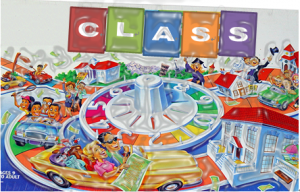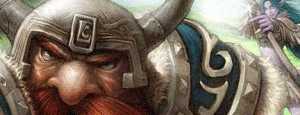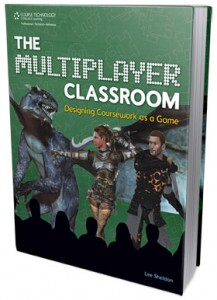
This is the fifth post on gamification in EFL. The first was an attempt to understand motivation. The second considered changing specific behaviors. The third looked at mechanics, or the structure needed to make game-based learning engaging. The fourth was about some of the problems that can happen when gamification (especially just pointsification–the casual addition of points and other game elements) is put to use for manipulative purposes without enough attention to the underlying motivations and personalities of learners. This post will look at turning your whole class into a game, or put more metaphorically, going the whole hog. There are really two ways of doing this. One is to design the course as a simulation. That means to create an immersive and realistic environment that requires learners to play a role. It is a kind of extreme content-based form of learning and requires considerable flexibility with curriculum content and probably works best if you are aiming learners at a specific career. An example might be simulating planning and opening a store for business students. The instructor would then need to create all the websites, documents, etc. needed to support the simulation. The second, and the one I’ll focus on in this post, involves re-imagining the present content using a role-playing game structure. Traditional content (including textbooks and teaching modules) are used, but a wider variety of tasks and assignments are used. Game genre details and a narrative structure are employed to make the progression through the material seem more like a game. This is more possible in institutional EFL courses, but still comes with a few conditions, the first being your familiarity with the genre of games.
Are you a gamer? I’m not talking about a little Angry Birds while commuting. I mean, have you spent huge blocks of your life immersed in World of Warcraft or Halo or The Sims or one of the many other places/pastimes where gamers spend time? Ask yourself how much you know about games and how much you really play. If you play 13 hours a week, you can consider yourself only an average member of the gamer sector of society; if you are up to 20 hours a week, you are officially “hard-core”; and if you can somehow cut your working, sleeping, and social hours down far enough to manage 45 hours a week, you are (by any account) “extreme” (McGonigal, 2011, p. 3). Of course, you don’t need to be a fanatic about games to turn your classroom into a game, but you do need a certain amount of familiarity with the genre. You will need rather intimate knowledge of the structure and pacing of games–the way items are acquired, the way quests go down, the types of challenges, the way characters interact, the reward systems, etc.–and you will need to be able to retool your classroom and syllabus in a way that mimics this. You will need to know the lingo: guilds, raids, wipes, (point) farming, experience points (XP), etc. Unsure of yourself? Back away from this idea now. But if you are a gamer and game lover, it is an option to embrace whole hoggedly. I speak as a researcher/observer here. I have not done this myself and so I will be only reporting on what I have read, pointing you to other sources and egging you to go out there and give it your best shot if you are interested.
There is, admittedly, something of a square peg in a round hole fit when taking the immersive multimedia world of a game and using it for a brick ‘n mortar face-to-face classroom. First of all, students are not sitting at computers interacting with audio/visual/narratives made by teams of talented professionals with an average production cost of $10 million (Whitton, 2010, in Using Games to Enhance Learning and Teaching). But if everyone is up for a bit of pretending, or suspension of disbelief, it can go well. Both Jane McGonigal in Reality is Broken, and Lee Sheldon in The Multiplayer Classroom believe that game culture is second nature for the students in our classes. They have grown up playing games and are very comfortable with the way games engineer player progression. Ms. McGonigal states that the members of the gamer generation have more problems with reality–including most school work–because it lacks interesting challenge, the satisfying work, promise of success, and actionable feedback that is usually the norm. In other words, most courses aren’t engaging for many learners and they are likely to be up for a change. Or as Mr. Sheldon optimistically puts it, “we have yet to discover a class that cannot be taught in this way” [as a game] (pg. 9).
Mr. Sheldon’s book is the best resource I’ve been able to find for designing coursework as a game. Indeed, that is the sub-title of the book. In addition to being a trial-and-error account of his attempts to do this with his own university game design courses, the book contains several case studies by different teachers, the closest one among them to a high school language course was Denishia Buchanan’s high school biology class. If you really have no idea where to begin, this book and in particular Ms. Buchanan’s case history, will help you out.
Mr. Sheldon will help you understand basic class organization and his unique (to the world of institutionalized education) approach to grading. By setting up coursework as a series of group and individual challenges and by creating a point system where students start with “0” and have to climb up through the levels towards their final grades, he manages (albeit not without a lot of tweaking) to make a grading system that mimics that of game progression.
In addition to just renaming groups as guilds and assignment as quests, both these teachers managed to make use of narrative to envelope the course and allowed learners considerable choice and flexibility. Narrative pulls the players/learners forward, making the course a story–their story; it creates in learners the desire to achieve hero goals; and it keeps everyone looking forward to what will happen next (Dansky, 2007). For this to work, however, there must be challenging but achievable things to do. Adoption of an inquiry-based curriculum that provides both variety and flexibility and lets the learners put their creativity to work seems a prerequisite. The balance, however, of choice and rigorous requirements seems to be a tricky one to manage (Whitton, 2012).
And even if you get that right, you’ll need to spend some time designing to facilitate greater interaction. Though it is often touted as a great feature of online games, the forming of groups to combine strengths to overcome particularly difficult challenges is not as common as game proponents might suggest. Ducheneaut (2006) studied World of Warcraft and found that players only begin to start grouping at the latter stages of game play at higher levels of the game, after they have found what they cannot do alone. That means that you can’t expect learners to collaborate on their own; you’ll have to design your activities so that group sharing is facilitated. Mr. Sheldon, for example, required both individual and group assignments during his courses, a practical way of ensuring both accountability and collaboration.
But finally, even if you get everything right, you still might not make everyone happy. There is considerable research that suggests that not all students like to experience courses as games, especially as one of those role-playing types of games that can can sound so hokey to the non-fan (Bekebrede et al., 2011).
Well, there you go. It’s obviously a challenge. It’ll take a lot of time to design all the quests and restructure the flow of lessons. But reading the stories of teachers who have done it can help you see the attraction of going whole hog with turning your course into a game. If you think you might like a little help with creating the structure and rule details, there is now a web service to help you. Called World of Classcraft, it provides roles, progressions, and rules of acquiring experience points or taking damage hit points.
And finally, you can read about an attempt to turn a language course into a large-scale alternate reality game (ARG) in Europe in Connolly, Stansfield, and Hainey (2011) linked below.
June 2013 Update: I recently came across a blog post from a teacher who had tried to gamify her class (as in turn the classroom experience into something closer to that of a game). Titled How I Turned My Classroom into a ‘Living Video Game’ and Saw Achievement Soar, the post explains (frustratingly) briefly how Ms Joli Barker, a second year elementary school teacher used technology (Skype, QR codes, GoAnimate, Voki, and Xtranormal), project-based learning narratives (?), and some international exchanges to boost the scores of her students quite dramatically. She created a basic structure of tasks and levels, challenges, and avatars, and re-tooled her assessment in a way that matches video games (similar to Mr. Sheldon). Without a little more detail, it is hard to picture what classes were really like, but the idea is very interesting and the results impressive.
Another June, 2013 update: Here is a geography class taught as a zombie survival game.
Bekebede, G., Warmelink, H., and Mayer, I. (2011). Reviewing the need for gaming in education to accommodate the net generation. Computers & Education, 57/2, 1521-1529.
Connolly, T. M., Stansfield, M., & Hainey, T. (2011). An alternate reality game for language learning: ARGuing for multilingual motivation. Computers & Education, 57(1), 1389-1415. doi:10.1016/j.compedu.2011.01.009
Dansky, R. (2007). Introduction to game narrative. In C.M. Bateman (ed.) Game writing: Narrative skills for video games. Boston, MA: Charles River Media.
Whitton, N. (2012). Good game design is good learning design. In N. Whitton and A. Moseley (eds.) Using games to enhance learning and teaching. New York: Routledge.
Also in this EFL gamification series:
Part 1: Intrinsic and Extrinsic Rewards
Part 2: Triggers, Ability, and Motivation
Part 4: The Downside and How to Avoid It

